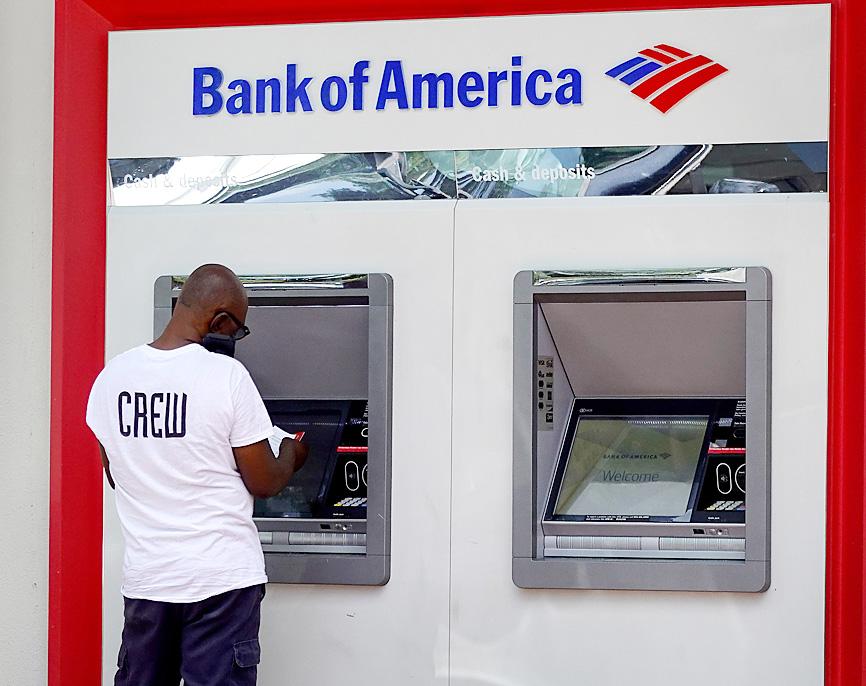Despite mounting worries over inflation, just-released bank earnings painted a resilient picture of the US economy and consumers, generating talk that any recession might be milder than earlier downturns.
Reports from six US banking giants showed a significant drop in profits from the heady year-ago period, with most of the group establishing fresh provisions in case of defaults.
Executives expressed caution about what is to come in light of the growing hit from higher gasoline and food prices, along with the burden of increased lending costs following several US Federal Reserve interest rate hikes and persistent supply chain problems.

Photo: AFP
However, banks still have not seen a significant rise in charge-offs from bad loans. They say many households still have a buffer of savings after conserving funds during the height of the COVID-19 pandemic when the federal government had generous relief programs.
Citigroup Inc chief financial officer Jane Fraser noted “sharply lower” consumer confidence compared with earlier in the year.
“That said, while sentiment has shifted, little of the data I see tells me the US is on the cusp of a recession,” Fraser said on Friday, adding that household savings provided “a cushion for future stress” amid a tight job market.
Fraser contrasted the backdrop in the US with Europe, where vulnerability to Russian energy could make for a “difficult winter.”
Executives acknowledged that the rising price of fuel and other essential goods poses burden to low-income households who are cutting back. However, most of the bank’s clients are not in this situation now.
“US consumers remain quite resilient,” Bank of America Corp chief executive officer Brian Moynihan said on Monday. “Consumers continue to spend at a healthy pace even as some time has passed since the receipt of any stimulus.”
JPMorgan Chase & Co chief executive officer Jamie Dimon described consumers as “in great shape,” which means that even if there is a recession, they are entering it in “far better shape” compared with 2008 or 2009.
On Monday, Bank of America reported US$6.2 billion in second-quarter profits, a 34 percent drop compared with a year earlier, when results were lifted by a large reserve release amid a strengthening macroeconomic backdrop.
In spite of weakness in some parts of the business, results were boosted by higher net interest income following Fed rate hikes. Bank of America also enjoyed growth in overall loans and pointed to “improvement” in overall asset quality.
At Goldman Sachs Group Inc — the final of the US banking giants to report — profits fell 48 percent to US$2.8 billion, again due in part to its decision to set aside US$667 million in provisions for credit losses.
Operations were mixed, with a big jump in revenues tied to trading amid volatile markets offsetting the hit from a drop in revenues connected to mergers and acquisition advising and loan underwriting. The reports came on the heels of similar releases last week from JPMorgan Chase, Citigroup, Morgan Stanley and Wells Fargo & Co.
Stuart Plesser, a senior director at S&P Global Ratings, described the industry’s overall tone as muted.
“They’re not saying anything’s disastrous, they’re not optimistic, either,” Plesser said.
“If you read the news, you got this possibility with inflation, the higher rate increases and all the other issues, but you can’t point to anything in the results,” he added.

The US dollar was trading at NT$29.7 at 10am today on the Taipei Foreign Exchange, as the New Taiwan dollar gained NT$1.364 from the previous close last week. The NT dollar continued to rise today, after surging 3.07 percent on Friday. After opening at NT$30.91, the NT dollar gained more than NT$1 in just 15 minutes, briefly passing the NT$30 mark. Before the US Department of the Treasury's semi-annual currency report came out, expectations that the NT dollar would keep rising were already building. The NT dollar on Friday closed at NT$31.064, up by NT$0.953 — a 3.07 percent single-day gain. Today,

‘SHORT TERM’: The local currency would likely remain strong in the near term, driven by anticipated US trade pressure, capital inflows and expectations of a US Fed rate cut The US dollar is expected to fall below NT$30 in the near term, as traders anticipate increased pressure from Washington for Taiwan to allow the New Taiwan dollar to appreciate, Cathay United Bank (國泰世華銀行) chief economist Lin Chi-chao (林啟超) said. Following a sharp drop in the greenback against the NT dollar on Friday, Lin told the Central News Agency that the local currency is likely to remain strong in the short term, driven in part by market psychology surrounding anticipated US policy pressure. On Friday, the US dollar fell NT$0.953, or 3.07 percent, closing at NT$31.064 — its lowest level since Jan.

Hong Kong authorities ramped up sales of the local dollar as the greenback’s slide threatened the foreign-exchange peg. The Hong Kong Monetary Authority (HKMA) sold a record HK$60.5 billion (US$7.8 billion) of the city’s currency, according to an alert sent on its Bloomberg page yesterday in Asia, after it tested the upper end of its trading band. That added to the HK$56.1 billion of sales versus the greenback since Friday. The rapid intervention signals efforts from the city’s authorities to limit the local currency’s moves within its HK$7.75 to HK$7.85 per US dollar trading band. Heavy sales of the local dollar by

The Financial Supervisory Commission (FSC) yesterday met with some of the nation’s largest insurance companies as a skyrocketing New Taiwan dollar piles pressure on their hundreds of billions of dollars in US bond investments. The commission has asked some life insurance firms, among the biggest Asian holders of US debt, to discuss how the rapidly strengthening NT dollar has impacted their operations, people familiar with the matter said. The meeting took place as the NT dollar jumped as much as 5 percent yesterday, its biggest intraday gain in more than three decades. The local currency surged as exporters rushed to